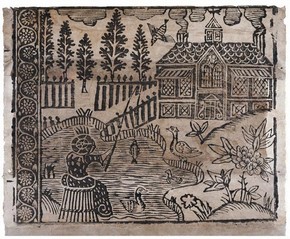If you were an important personage in 17th Century Antwerp, your house would be furnished with gilded leather wallpaper, a status symbol of the rich merchant. Inevitably this fashion spread to England. On a visit to The Hague, I took this picture in the Mauritshuis Museum, The Hague (left), but there are also good examples in the Rubenshuis Museum Antwerp (right).
Many not-quite-so rich households had walls covered by tapestries or decorative damask or fabric. These were stretched over a base of a linen canvas over a wooden frame, and often featured a co-ordinating border to disguise tack-heads.
Calico and chintz were the cheapest fabric wall coverings. Pepys records (5 September 1663) that he had bought his wife ‘a chinte … that is paynted Indian callico for to line her new study, which is very pretty’.
Less expensive still was the block-printed paper. Commonly, 17th-centu ry wallpapers were reproductions of the designs of ‘black-work’ – the popular embroidery of the time. The patterns were usually floral, or natural subjects such as butterflies or birds, or figures in a landscape. The actual embroideries were worked onto a white linen using black thread – hence the name.
ry wallpapers were reproductions of the designs of ‘black-work’ – the popular embroidery of the time. The patterns were usually floral, or natural subjects such as butterflies or birds, or figures in a landscape. The actual embroideries were worked onto a white linen using black thread – hence the name.
For wallpaper, the intricate designs were copied by woodcut printing. Few examples have survived on walls, but pieces have been found lining drawers and boxes. Even the stitches in the embroidery were copied, by skilful use of the chisel to make cross-hatching.
Hand-painted papers were imported from China in response to the expanding empire and the quest for all things exotic. these were also copied, and the block printed design would be hand-painted afterwards. Colour could be applied freehand or using a leather stencil, and the stencil technique continued to be used well into the 18th century as it was much cheaper than getting a wood carver to make a block.
Sources:



I like this web blog so much, saved to favorites.